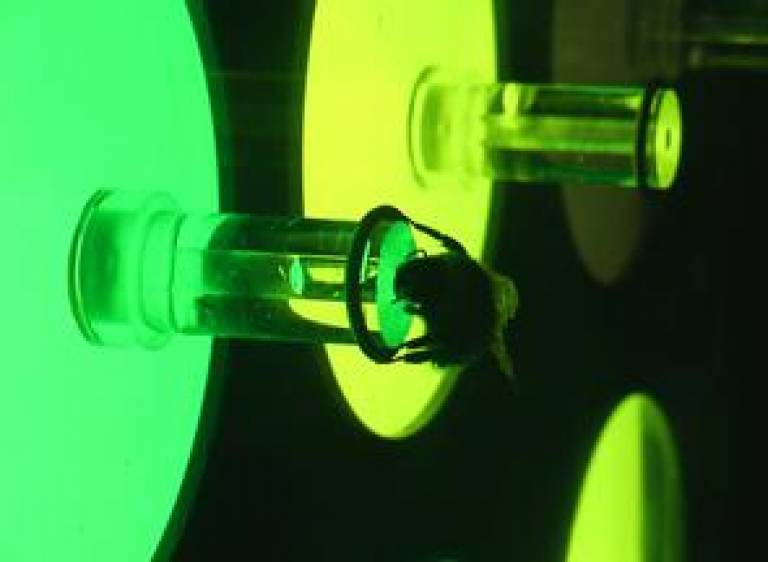Exploring light and colour
21 December 2005
UCL researchers have created 'AfterImage', a site-specific installation at London's Hayward Gallery which aims to provide a unique perspective on light and colour perception, as part of the gallery's exhibition 'Dan Flavin: A Retrospective', which runs from 19 January to 2 April 2006.

Dr Mark Lythgoe (UCL Institute of Child Health) and Dr R Beau Lotto (UCL Institute of Ophthalmology) together with Dr Mark Miodownik (King's College, London) designed the installation that explores Dan Flavin's work with light and colour. The generation of light, the phenomenon of fluorescence, and our relationship with colour are the main themes of the exhibit.
"The space juxtaposes light on the one hand and our perception of light on the other, and in so doing explores the enigmatic relationship between the two," explained Dr Lotto. Dr Lythgoe added: "The dual display of what is seen and what courses beneath the surface, brings us to the core substance of what we perceive in Flavin's work. It aims to make visible the connections between the scientific and artistic explorations of light and colour, probing the thin membrane between the 'reality' and our 'perception' of the physical world."
Dr Lythgoe has resurrected the theatre of Victorian electrostatics with the world's largest Wimshurst machine. He said: "The machine can generate up to 600,000 volts, and its salient motion draws striking sparks above a collection of images and stills that reflect the historical significance of the science behind Flavin's work."
In a second installation, designed by Dr Miodownik, darkened walls contain optically active objects that induce transformation in light. Dr Miodownik said: "We are using these objects as a vocabulary to deconstruct fluorescence and expose its animal, mineral and vegetable nature.
In the other half of the same space, Dr Lotto examines 'how and why context is everything, when it comes to what we see'. According to Dr Lotto, "The external world of light and our internal world of colour are far from simple, and by exploring this relationship we are trying to explain, not only how we see, but why we see what we do."
Neurophysiologist Dr Lythgoe has long been interested in the public's engagement with science, and in exploring the relationship between art and science. He has produced a number of films and pieces for exhibitions in collaboration with filmmakers and artists, and has collaborated with an artist-in-residence at the Institute of Child Health. Dr Lythgoe's scientific research utilises MRI techniques for investigating brain function and developing possible therapies for children suffering from stroke.
Dr Lotto is also a keen exponent of using science and art to explore and communicate the fundamental basis of natural brains, and has been previously involved in many public projects. His team of biologists, computer scientists and artists at the UCL Institute of Ophthalmology are interested in how the brain translates the huge amount of 'ambiguous' information that falls on our eyes into something 'meaningful'. In addition to work on humans, and the evolution of 'Artificial Life' networks that 'see', he has enlisted a cohort of bumblebees to help him in his quest and created a flight arena, or 'Bee Matrix' complete with artificial flowers. He is also working on adapting this research for use in visual applications for robots.
During the afternoons of 21January and 25 March 2006, Dr Lotto will conduct a series of experiments with bumblebees in the 'AfterImage' space. The aim is to demonstrate the fundamental interdependence between experience and perception that underlies visual illusions in animals, as diverse as bees and humans. Dr Miodownik and Dr Lythgoe will also be presenting demonstrations on 21 January, and Dr Lotto will deliver a public lecture on 21 March 2005 at the gallery entitled 'Light and Colour', where he will discuss the relationship between the external world of light, and our internal world of colour.
Image: The Bee Matrix
- Links:
- Hayward Gallery
- Dr Lythgoe
- Dr Lotto
 Close
Close

